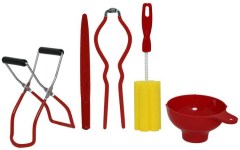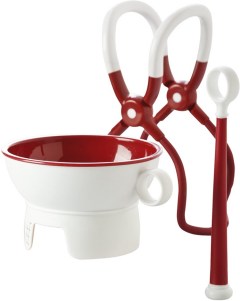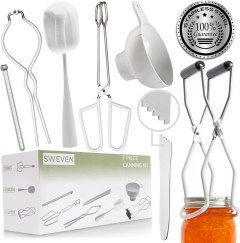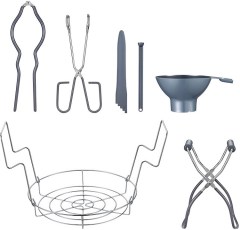Buying guide for Best canning sets
Whether you are an avid gardener or merely like to stock up on produce when it’s in season, you’re going to need some way to preserve your bounty in order to avoid wasting it. Canning is a low-cost way to preserve a variety of foods in a way that maintains both vitamins and minerals. It is also fairly simple to do, and nothing beats opening up your pantry on a cold winter’s day to find jar after jar of jam, tomatoes, and pickles that you put up yourself.
A water bath canning set is one of the simplest ways to begin your own canning adventure. These often include all the tools — and often the cookware — necessary to put up your own preserves. While canning sets are less expensive than selecting the tools separately, the included tools and their materials will vary from one set to the next.
Key considerations
Pot or no pot
There are two basic configurations of canning sets that you will run across: those that ship with a pot used for the water bath that is essential to the process, and those that do not. If a set does not include a pot, you will need to provide your own. Luckily, any stock pot with some form of a wire rack in it will suffice.
If a set does ship with a pot, know how large it is. These generally run in the 18- to 21- quart size, which is large enough to process around 7 quarts of food at a time. The larger the pot, the faster you can process food. The trade-off here is that a super large pot may be difficult to use and store.
The majority of pots are constructed from porcelain enamel over steel. While this will usually result in a fairly thin bottom and sides, it does provide for decent heat distribution, allowing the pot to heat quickly. Elements of a pot to keep an eye out for are sturdy handles and a domed lid to help trap heat.
Beware of any pot that seems to have problems with enamel chipping.
Jar racks
Jar racks — or lift screens — are an important part of a canning set and should be included with all sets that also feature a pot. If you are providing your own pot, you should also find some form of a rack to use within it.
A jar rack holds the jars as they are processed in the water bath. Jar racks are vital for keeping a consistent temperature around the jars and for keeping the jars away from the bottom of the pot where they can overheat and either harm the food you are trying to preserve or break the jar itself. A sturdy wire rack can also be used to lift the jars out of the water bath at the end of the processing period.
How easy is the set to clean?
While the tools can generally be run through your dishwasher (use the top rack), the pot may be another matter. Since dishwasher detergents can damage enamel, some manufacturers recommend washing a canning pot by hand.
Storage
When you’re not using it, how easy is the canning set to put away? The best sets are designed so all parts can easily fit within the pot. Not only does this take up less space, but you will also be less likely to lose various tools.
Features
Tools
Canning set tools have one important function: to keep you from scalding yourself during the canning process. To this end, tools are often coated for additional protection from the heat. Tool sets will vary both in terms of the type and number of tools included. Some common canning tools that will likely be in any set you consider include:
- A jar lifter: A jar lifter can be used to lift a hot jar out of the water bath. This is also a handy tool for safely moving around sterilized jars prior to processing.
- A lid lifter: Usually magnetized, lid lifters are used to easily remove lids from hot water after they have been sterilized.
- A funnel: With a funnel, you can easily pour food into a sterilized jar without making a mess. The best funnels will fit both regular or wide-mouth jars.
- A jar wrench: A jar wrench or jar opener is used to easily screw on or off a hot lid, regardless of its size.
- A bubble remover: A decent bubble remover provides two functions: dislodging bubbles from the sides and bottom of jarred food and providing ruler markings so you leave the proper amount of headspace in your jars.
Some tool sets will also include additional tools such as tongs for handling hot food and digital timers to process food correctly.
Included accessories
While not standard, some canning sets go the extra yard by including extras such as:
- A colander: This is handy for cleaning foods prior to packing them into jars.
- A blanching pot: You can use a blanching pot for partially cooking — or blanching — foods prior to freezing or canning them. This is also handy for removing the skins from foods such as tomatoes.
- An instruction booklet: While information on water bath canning abounds on the Internet, it is still nice to have a handy guide to start you on your way.
"Canning as a process was invented in 1809 by Nicolas Appert as a way to help the French army and navy better preserve their food."
STAFF
BestReviews
Canning set prices
Water bath canning sets can start out at under $15 and can reach upwards of $50 to $60.
At the lower end, you’re generally only getting a tool set. You will need to provide your own pot and rack. Tool sets start out around $10 and can reach $15 to $20 or higher for a quality set.
More expensive sets will include a pot and rack. You will also tend to find a higher quality all around in addition to more tools and accessories. Sets costing around $60 may include extras such as a colander or blanching pot.
Tips
- Don’t neglect the bubble removal tool when you are preparing to seal your jars for water bath processing. Air bubbles in a jar of jam or tomatoes can cause an increase in pressure, which can break a jar or affect its seal.
- Once lids are sterile, you should not touch them with your hands prior to processing the jars. This is where a magnetic lid lifter is handy.
- Hosted by the University of Georgia, the National Center for Home Food Preservation should be in your bookmarks if you are serious about canning. This site hosts a wealth of tips and FAQs covering all methods of food preservation from canning and freezing to drying and smoking.
- The boiling water level in your pot should be one to two inches over the jar tops to effectively process the jars.
- If your canning pot includes a flimsy rack, you will likely find that removing individual jars from a water bath with a jar lifter is going to be much safer than trying to lift all the jars at once using the rack.
- The “headspace” in a canning jar refers to the empty space between the food and the bottom of the jar lid. The recommended measurements for water bath canning — which you can measure with a marked bubble remover — is 1/4 inch for jams and jellies and 1/2 inch for tomatoes or fruit.
- It is recommended that you sterilize all empty jars used in water bath canning by boiling them for ten minutes before draining and filling the jars. Note: you can skip the sterilization step if your processing time will be ten minutes or longer.
FAQ
Q. Do these canning sets work on an induction range?
A. The majority of water bath canning pots available are constructed from porcelain with a metal center. As such, they should work with an induction range. We recommend consulting the manufacturer if you have any questions about induction compatibility, however.
Q. What is the difference between water bath canning and pressure canning?
A. The two primary methods of preserving foods by canning are water bath canning and pressure canning. Water bath canning is a lower temperature process and is ideal for preserving high acid foods. This is the preferred canning method for foods such as salsas, fruits, jams and jellies, tomatoes, pickles, and condiments. As the name implies, pressure canning uses pressure — usually with a specialized pressure cooker — to achieve a higher temperature. This is really the only safe canning way to preserve low acid foods such as meats, vegetables, seafood, and chili.
Q. Can I use a canning set pot to cook down jam or tomato sauce before canning them?
A. While these pots are highly effective for creating water baths used in the canning process, their design — thin bottoms with high sides — will likely lead to scorched sauces, unless you want to stir the pot every few seconds.



















